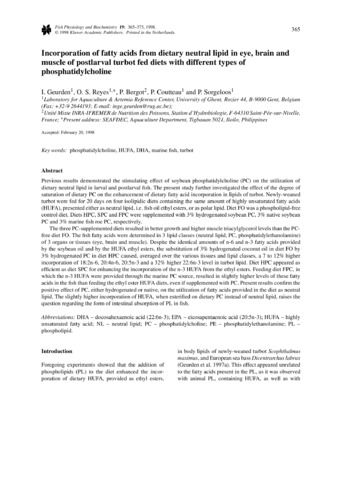Fatty acid composition of five candidate aquaculture species in Central Philippines
| dc.contributor.author | Ogata, Hiroshi Y. | |
| dc.contributor.author | Emata, Arnil C. | |
| dc.contributor.author | Garibay, Esteban S. | |
| dc.contributor.author | Furuita, Hirofumi | |
| dc.date.accessioned | 2014-05-12T03:29:57Z | |
| dc.date.available | 2014-05-12T03:29:57Z | |
| dc.date.issued | 2004 | |
| dc.identifier.citation | Ogata, H. Y., Emata, A. C., Garibay, E. S., & Furuita, H. (2004). Fatty acid composition of five candidate aquaculture species in Central Philippines. Aquaculture, 236(1-4), 361-375. | en |
| dc.identifier.issn | 0044-8486 | |
| dc.identifier.uri | http://hdl.handle.net/10862/2022 | |
| dc.description.abstract | Fatty acid composition was determined in five candidate aquaculture species, mangrove red snapper (Lutjanus argentimaculatus), two rabbitfish (Siganus guttatus and S. canaliculatus), coral trout (Plectropomus leopardus) and striped jack (Caranx fulvoguttatus) sampled in the Central Philippines. Special attention was paid to arachidonic acid (ARA), eicosapentaenoic acid (EPA) and docosahexaenoic acid (DHA). Total lipids of hatchery-produced eggs and newly hatched larvae of mangrove red snapper unexpectedly had equal levels of ARA and EPA. Ovarian polar lipids were subsequently found to have intermediate or high ARA (5.5–10.7%) and DHA (14.4–20.4%) levels but relatively low EPA levels (1.5–1.9%), consequently showing high ARA/EPA (4.4–6.0) and DHA/EPA (7.4–14.9) ratios in wild mangrove red snapper and rabbitfish (S. guttatus and S. canaliculatus). Similar trends were observed even in hatchery-reared mangrove red snapper, rabbitfish (S. guttatus) and coral trout. Not only ovary but also liver and muscle contained relatively higher ARA compared with EPA in mangrove red snapper, regardless of the sample source. ARA, EPA and DHA levels in the polar lipids of wild fry (whole body) ranged respectively from 3.2% to 4.0%, from 2.7% to 4.7% and from 23.5% to 27.6% with intermediate or high ARA/EPA (0.8–1.5) and DHA/EPA (5.9–8.8) ratios in mangrove red snapper, rabbitfish (S. canaliculatus) and striped jack. As overall traits, the five species in the Central Philippines appear to have intermediate or high ARA and DHA levels with low EPA level, consequently having high ARA/EPA and DHA/EPA ratios compared to species in high and temperate northern hemisphere. Thus, the present results indicate that ARA is not a minor component in the tropical species, suggesting that ARA may be nutritionally much more important for egg development and larvae growth in the tropical species than in cold water species. The information of the present study can be used as a guideline for development of appropriate broodstock and/or larval diets in the Philippines. | en |
| dc.description.sponsorship | We would like to thank K.D. Shearer, Northwest Fisheries Science Center, NMFS, Seattle, WA, USA, for his critical reading of the manuscript. This study was supported by the collaborative project titled “Studies on Sustainable Production Systems of Aquatic Animals in Brackish Mangrove Areas’’ between Japan International Research Center for Agricultural Sciences, Japan and the Aquaculture Department, SEAFDEC, Philippines. | en |
| dc.language.iso | en | en |
| dc.publisher | Elsevier | en |
| dc.subject | Lutjanus argentimaculatus | en |
| dc.subject | Plectropomus leopardus | en |
| dc.subject | Siganus guttatus | en |
| dc.subject | Philippines | en |
| dc.subject | Caranx | en |
| dc.subject | docosahexaenoic acid | en |
| dc.subject | eicosapentaenoic acid | en |
| dc.subject | essential fatty acids | en |
| dc.subject | Lutjanus | en |
| dc.title | Fatty acid composition of five candidate aquaculture species in Central Philippines | en |
| dc.type | Article | en |
| dc.identifier.doi | 10.1016/j.aquaculture.2003.10.015 | |
| dc.citation.volume | 236 | |
| dc.citation.issue | 1-4 | |
| dc.citation.spage | 361 | |
| dc.citation.epage | 375 | |
| dc.citation.journalTitle | Aquaculture | en |
| seafdecaqd.databank.controlnumber | 2004-10 | |
| dc.subject.asfa | aquaculture development | en |
| dc.subject.asfa | arachidonic acid | en |
| dc.subject.asfa | biochemical composition | en |
| dc.subject.asfa | breeding stock | en |
| dc.subject.asfa | diet | en |
| dc.subject.asfa | embryonic development | en |
| dc.subject.asfa | fatty acids | en |
| dc.subject.asfa | fish culture | en |
| dc.subject.asfa | fish larvae | en |
| dc.subject.asfa | larval stage | en |
| dc.subject.asfa | lipids | en |
| dc.subject.asfa | mangroves | en |
| dc.subject.asfa | marine fish | en |
| dc.subject.asfa | eggs | en |
| dc.subject.asfa | larvae | en |
| dc.subject.asfa | ovaries | en |
| dc.subject.scientificName | Caranx fulvoguttatus | en |
このアイテムのファイル
| ファイル | サイズ | フォーマット | 閲覧 |
|---|---|---|---|
|
このアイテムに関連するファイルは存在しません。 |
|||
このアイテムは次のコレクションに所属しています
-
Journal Articles [1258]
These papers were contributed by Department staff to various national and international journals.




